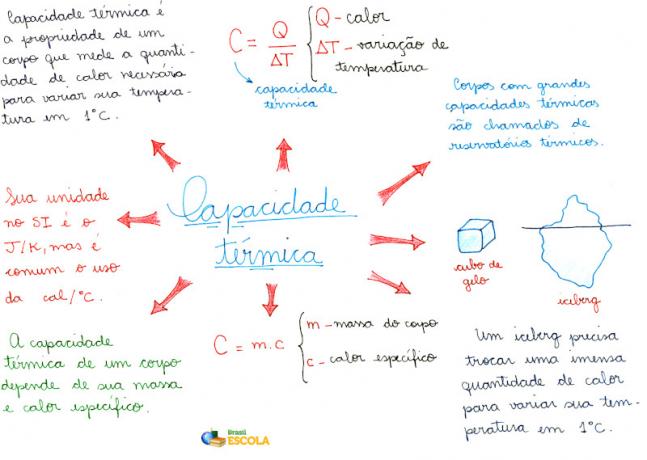THE thermal capacity and the amount of heat which must be absorbed or given up by a body for a variation of 1 °C to occur. Mathematically, this magnitude is the result of reason between the amount of heat and the variation in temperature suffered by any object:

The terms of the equation and their corresponding units of measure are:
Ç = Thermal capacity (cal/°C);
Q = Amount of heat (lime);
ΔT = Temperature variation (°C or K).
Note that the temperature variation can be indicated either in the Celsius scale how much in Kelvin scale. This is possible because the two thermometric scales are centigrade, that is, divided into 100 intervals.
Relationship to body mass
Thermal capacity can be written as a function of body mass. For this, we must substitute in the equation before the equation for determining the amount of heat given or received by a body:

In this equation, the thermal capacity of any body is defined as the product of body mass (m) by its specific heat (c), characteristic of the material that makes up the body. Here we can see that, if there are two different amounts of the same material, the greater amount will present the greater thermal capacity, that is, it will need a greater amount of energy to undergo a temperature variation corresponding to 1 °C.
Mind Map: Thermal Capacity

*To download the mind map in PDF, Click here!
Watch out!
The word “capacity” can convey the idea that the body has a maximum limit of heat that can be received or absorbed. This idea is wrong! As much as the term used is thermal capacity, there is no limit to the amount of heat that can be exchanged for an object.
everyday example
The incandescent sparks, released by the friction generated by an emery, when hitting a worker, do not cause burns. This is because the mass of the sparks is infinitely small, which makes the thermal capacity negligible.
By Joab Silas
Graduated in Physics
*Mental Map by Me. Rafael Helerbrock
Source: Brazil School - https://brasilescola.uol.com.br/o-que-e/fisica/o-que-e-capacidade-termica.htm

